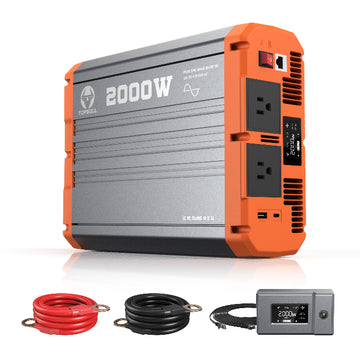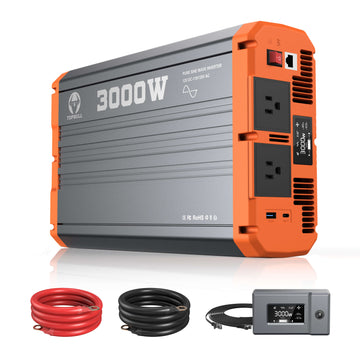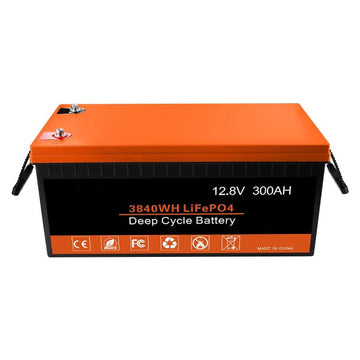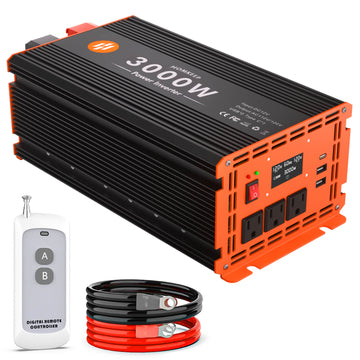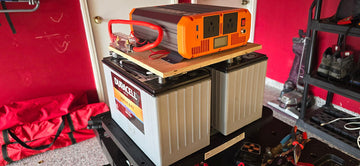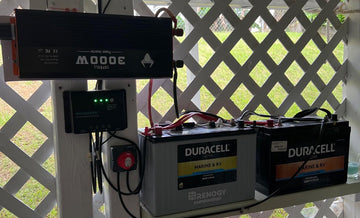Of the many battery types available, AGM (Absorbed Glass Alkaline Lead Acid) and Lithium batteries are two of the most common choices. This article will take an in-depth look at the characteristics of AGM batteries, how they work, their advantages and disadvantages, as well as the main differences between them and lithium batteries, and provide recommendations for maintenance and use.
What is AGM battery
AGM batteries are a type of lead-acid batteries. AGM batteries use a glass fiber spacer as the electrolyte carrier inside the battery, and a pure aqueous sulfuric acid solution as the electrolyte to generate electrical energy through a chemical reaction. This design allows the electrolyte inside the battery to be effectively absorbed and immobilized, thus realizing the sealed and maintenance-free characteristics of the battery.
Inside the AGM battery, most of the electrolyte is adsorbed in the glass fiber membrane, while a portion of the electrolyte is also absorbed inside the pole plate. This liquid-poor design allows the battery to maintain a stable battery reaction environment during charging and discharging. In order to provide a pathway for oxygen precipitated from the positive electrode to the negative electrode, the diaphragm maintains 10% of its pores unoccupied by electrolyte. The poles are tightly assembled so that the plates are in full contact with the electrolyte, while the plates are designed to be thicker and are made of a special alloy to improve the performance and life of the battery.
Working Principle of AGM Battery
AGM batteries (Absorbed Glass Fiber Lead Acid Batteries) work similarly to conventional lead acid batteries, but their special structure and design give them significant advantages in performance and safety. The following are the basic operating principles of AGM batteries:
1. Composition
AGM batteries are mainly composed of the following parts:
- Positive electrode: usually made of lead dioxide (PbO2) as the positive electrode of the current.
- Negative electrode: made of lead sponge (Pb), as the negative electrode of the current.
- Electrolyte: In AGM batteries, the electrolyte (dilute sulfuric acid) is absorbed in a glass fiber spacer, creating a solid state and reducing the use of liquid.
2. Charging process
During charging, current passes through the battery and the following reactions are generated by the chemical reaction between the positive and negative electrodes:
- On the positive electrode (PbO2), lead dioxide reacts with hydrogen ions in the electrolyte to produce water and lead ions.
- On the negative electrode (Pb), lead sponge reacts with sulfuric acid in the electrolyte to produce lead ions and sulfate.
3. Discharge process
During discharge, the AGM battery provides current to supply electricity. The reactions during discharge are as follows:
- At the negative electrode, lead sponge reacts with the sulfuric acid in the electrolyte and transforms into lead ions and sulfate ions.
- At the positive electrode, lead dioxide reacts to form lead dioxide and water.
- Through this process, the battery is able to generate current to supply various devices.
4. Key Features
- Sealed structure: AGM batteries are sealed, the electrolyte will not leak out, increasing safety.
- Low self-discharge rate: AGM batteries have a low self-discharge rate, making them convenient for long-term storage and use.
- High discharge capacity: AGM batteries are able to deliver high current in a short period of time, suitable for applications that require instantaneous discharge of high current.
Through these chemical reactions, AGM batteries are able to store and release power efficiently for automotive, UPS, and many other applications.
Advantages and disadvantages of AGM batteries
Advantages
- Long life:AGM batteries have a longer lifespan because they have a 3 times higher cycle charge capacity than traditional lead-calcium batteries. This means that users can use the battery for a longer period of time, reducing the frequency and cost of battery replacement.
- High electrical capacity stability:AGM batteries are able to maintain high capacity stability throughout their life cycle. This means that the battery can provide a stable power output in different stages of use to meet the various needs of users.
- Reliable low temperature performance:AGM batteries exhibit more reliable performance at low temperatures. This allows it to maintain efficient power output in cold climates, meeting the needs of users in cold regions.
- Environmentally Safe:AGM batteries have a 100% sealed design, which can effectively prevent acid leakage, thus reducing the risk of accidents and environmental pollution. This design also reduces the risk of safety hazards for users during use.
- Simple Maintenance:Maintenance of AGM batteries is relatively simple, reducing the need for deep discharge. Users do not need to perform frequent operations such as adding acid or replenishing water like traditional batteries, reducing maintenance costs and time.
- Rapid Charge and Discharge Capability:AGM batteries are able to withstand multiple discharges and recharges with high currents in a short period of time, which makes them perform well in application scenarios that require fast charging and discharging, such as start-stop systems.
- High energy density:Although AGM batteries may have a slightly lower discharge capacity than some other types of batteries, they still have a higher energy density and are able to provide more power in a limited size and weight.
Disadvantages
- Higher cost:AGM batteries typically cost more compared to traditional lead-acid batteries. This is mainly due to their use of more advanced materials and design.
- Higher weight:AGM batteries are heavier compared to lightweight batteries such as lithium batteries. This limits their use in portable devices to some extent.
- Relatively low discharge capacity:AGM batteries may have a slightly lower discharge capacity compared to open cell batteries and certain other types of sealed batteries. This is primarily a result of their lower electrolyte volume and lower active substance utilization. However, under normal conditions of use, this difference usually does not affect the user too much.
AGM batteries have significant advantages in terms of long life, high capacity stability, low-temperature performance, environmental protection and safety, simple maintenance, and fast charging and discharging capabilities, but higher cost and heavier weight are their main disadvantages. Users should weigh their specific needs and budget when choosing a battery. Reaction, AGM batteries are able to store and release power efficiently, and are suitable for use in automobiles, UPS, and many other fields.
AGM Battery Application Scenarios
AGM batteries are widely used in automotive and motorcycle applications due to their superior performance and safety features, especially when high starting currents are required. Their hermetically sealed design allows them to operate under extreme environmental conditions, such as high and low temperatures and vibration environments, which makes AGM batteries ideally suited for use in the power supply of off-road vehicles, racing cars and heavy machinery.
In addition, AGM batteries are widely used in renewable energy systems, such as solar energy storage and wind energy storage. Due to their excellent deep cycle capability and maintenance-free design, AGM batteries are able to effectively store solar or wind energy to provide a stable power supply, which makes them particularly suitable for applications requiring a long-time backup power supply, such as power solutions for outdoor activities, home backup power, and communication equipment.
How long does an AGM battery last?
AGM batteries usually last between 3 and 5 years, depending on the usage environment and the frequency of charging and discharging. Under optimal conditions, the cycle life of AGM batteries can reach 600 to 1000 cycles.
Under normal use conditions, the service life of AGM batteries may be longer if they are well maintained and cared for, such as regular charging, avoiding over-discharging and over-charging, and keeping the battery surface clean. In addition, the use environment and conditions will also have an impact on the service life of AGM batteries, such as high temperature, low temperature, humidity and other harsh environments may accelerate the aging and damage of the battery.
Therefore, in order to prolong the service life of AGM batteries, users should make a reasonable use and maintenance plan according to the use of batteries and environmental conditions, and check the status and performance of batteries regularly. If any abnormality or failure is found in the battery, it should be repaired or replaced in time.
AGM Battery VS Lithium Battery, what is the difference between them?
AGM batteries and Li-ion batteries are two common types of batteries, each with significant differences in performance, weight, life and cost, etc. AGM batteries are widely used in automobiles and backup power supplies due to their low initial cost and good high-current discharge characteristics, while Li-ion batteries are becoming the preferred choice for electric vehicles, portable devices and high-performance applications due to their high energy density, light weight and long cycle life.
| Characteristics | AGM Battery | Lithium Battery |
| Chemical composition | Lead acid | Lithium and its compounds |
| Energy Density | 30-50 Wh/kg | 150-250 Wh/kg |
| Weight | Heavier | Lightweight |
| Charging speed | Slow, several hours | Fast, 1-2 hours |
| Cycle life | 500-1000 cycles | 2000-5000 cycles |
| Discharge Characteristics | Slightly weak in high current, poor in low temperature | Superior, adaptable to wide temperature range |
| Costs | Low initial investment | High initial investment |
| Maintenance Requirements | Maintenance free | Maintenance free but requires a dedicated charging system |
| Environmentally friendly | Contains lead, difficult to handle | More environmentally friendly but requires careful extraction |
How can I tell if my battery is an AGM battery?
There are several ways to determine if a battery is an AGM battery:
1. Labeling and Marking
- Check the battery label: Most batteries have a type on the label, such as “AGM” or “Absorbent Glass Mat”. If you can't find it, check the manufacturer's brand and model number, and search online for relevant information.
2. Appearance Characteristics
- Shape and construction: AGM cells are usually closed and have a smooth surface, some models may have vents. They are generally rectangular in shape, relatively heavy, and have no visible liquid electrolyte. In addition, because AGM batteries use a fiberglass spacer inside to absorb the electrolyte, you won't hear the liquid sloshing around when you shake the battery.
3. Weight and Size
- Comparing weight: AGM batteries are usually heavier due to the use of lead and special electrolyte materials. If the weight of the battery is relatively heavy and the size is moderate, it may be an AGM battery.
4. Charging and Discharging Characteristics
- Charging method: AGM batteries are suitable for charging with a smart charger. If the charger you use is designed for AGM, this may be an indication.
- Discharge: AGM batteries usually have good discharge performance, but if you frequently encounter batteries discharging too quickly, you may need to confirm this further.
5. Check the owner's manual or technical specifications
- Refer to the manual: If the battery is new to the unit you bought, you can refer to the owner's manual or relevant technical documentation, where the battery type is usually stated.
6. Battery Cover
- No venting holes: AGM batteries have almost no venting holes or vents because they are sealed. If the battery has venting holes, it is most likely not an AGM battery, but a regular lead-acid battery.
FAQs
What is the difference between AGM batteries and traditional lead-acid batteries?
The main difference between AGM batteries and conventional lead-acid batteries is the state of the electrolyte. AGM batteries have the electrolyte absorbed in glass fibers, so they are sealed and not prone to leakage, whereas conventional lead-acid batteries contain a liquid electrolyte.
Are AGM batteries safe?
AGM batteries are relatively safe because they are sealed, do not easily leak electrolyte, and do not produce hydrogen gas under normal use.
What is the charging time for AGM batteries?
The charging time for AGM batteries is usually between 4 and 8 hours, depending on the output of the charger and the remaining charge of the battery.
Do AGM batteries require maintenance?
AGM batteries are generally maintenance free and do not require regular electrolyte replenishment, but they still need to be checked regularly for voltage and good battery connection.
What are the storage conditions for AGM batteries?
AGM batteries should be stored in a dry, cool environment and are recommended to be stored within the temperature range (-20°C to 50°C). When not in use for an extended period of time, charge periodically to maintain battery condition.
How to handle AGM batteries safely?
When disposing of or dumping AGM batteries, follow local hazardous waste regulations. Do not throw them away, but give them to a professional recycling center for disposal.

